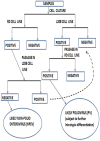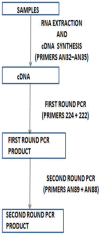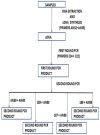Defining the Enterovirus Diversity Landscape of a Fecal Sample: A Methodological Challenge?
- PMID: 26771630
- PMCID: PMC4728578
- DOI: 10.3390/v8010018
Defining the Enterovirus Diversity Landscape of a Fecal Sample: A Methodological Challenge?
Abstract
Enteroviruses are a group of over 250 naked icosahedral virus serotypes that have been associated with clinical conditions that range from intrauterine enterovirus transmission withfataloutcome through encephalitis and meningitis, to paralysis. Classically, enterovirus detection was done by assaying for the development of the classic enterovirus-specific cytopathic effect in cell culture. Subsequently, the isolates were historically identified by a neutralization assay. More recently, identification has been done by reverse transcriptase-polymerase chain reaction (RT-PCR). However, in recent times, there is a move towards direct detection and identification of enteroviruses from clinical samples using the cell culture-independent RT semi-nested PCR (RT-snPCR) assay. This RT-snPCR procedure amplifies the VP1 gene, which is then sequenced and used for identification. However, while cell culture-based strategies tend to show a preponderance of certain enterovirus species depending on the cell lines included in the isolation protocol, the RT-snPCR strategies tilt in a different direction. Consequently, it is becoming apparent that the diversity observed in certain enterovirus species, e.g., enterovirus species B(EV-B), might not be because they are the most evolutionarily successful. Rather, it might stem from cell line-specific bias accumulated over several years of use of the cell culture-dependent isolation protocols. Furthermore, it might also be a reflection of the impact of the relative genome concentration on the result of pan-enterovirus VP1 RT-snPCR screens used during the identification of cell culture isolates. This review highlights the impact of these two processes on the current diversity landscape of enteroviruses and the need to re-assess enterovirus detection and identification algorithms in a bid to better balance our understanding of the enterovirus diversity landscape.
Keywords: cell culture; enterovirus diversity landscape; enteroviruses; species bias.
Figures



Similar articles
-
Sensitive, seminested PCR amplification of VP1 sequences for direct identification of all enterovirus serotypes from original clinical specimens.J Clin Microbiol. 2006 Aug;44(8):2698-704. doi: 10.1128/JCM.00542-06. J Clin Microbiol. 2006. PMID: 16891480 Free PMC article.
-
Preponderance of enterovirus C in RD-L20B-cell-culture-negative stool samples from children diagnosed with acute flaccid paralysis in Nigeria.Arch Virol. 2017 Oct;162(10):3089-3101. doi: 10.1007/s00705-017-3466-2. Epub 2017 Jul 10. Arch Virol. 2017. PMID: 28691129
-
[Identification of enteroviruses from central nervous system infections by RT-PCR and cell culture methods].Mikrobiyol Bul. 2011 Jul;45(3):468-77. Mikrobiyol Bul. 2011. PMID: 21935780 Turkish.
-
New enteroviruses, EV-93 and EV-94, associated with acute flaccid paralysis in the Democratic Republic of the Congo.J Med Virol. 2007 Apr;79(4):393-400. doi: 10.1002/jmv.20825. J Med Virol. 2007. PMID: 17311342
-
Basic rationale, current methods and future directions for molecular typing of human enterovirus.Expert Rev Mol Diagn. 2007 Jul;7(4):419-34. doi: 10.1586/14737159.7.4.419. Expert Rev Mol Diagn. 2007. PMID: 17620049 Review.
Cited by
-
Evaluation of GeneXpert EV assay for the rapid diagnosis of enteroviral meningitis: a systematic review and meta-analysis.Ann Clin Microbiol Antimicrob. 2022 Jun 9;21(1):25. doi: 10.1186/s12941-022-00517-3. Ann Clin Microbiol Antimicrob. 2022. PMID: 35681153 Free PMC article.
-
Enterovirus Infections in Solid Organ Transplant Recipients: a Clinical Comparison from a Regional University Hospital in the Netherlands.Microbiol Spectr. 2022 Feb 23;10(1):e0221521. doi: 10.1128/spectrum.02215-21. Epub 2022 Feb 9. Microbiol Spectr. 2022. PMID: 35138120 Free PMC article.
-
Laboratory diagnosis of nonpolio enteroviruses: A review of the current literature.Biosaf Health. 2022 Dec 28;5(2):112-119. doi: 10.1016/j.bsheal.2022.12.002. eCollection 2023 Apr. Biosaf Health. 2022. PMID: 40078831 Free PMC article. Review.
-
Enteroviruses in Water: Epidemiology, Detection and Inactivation.Environ Microbiol. 2025 May;27(5):e70109. doi: 10.1111/1462-2920.70109. Environ Microbiol. 2025. PMID: 40390239 Free PMC article. Review.
-
Identification of specific and shared epitopes at the extreme N-terminal VP1 of Coxsackievirus A4, A2 and A5 by monoclonal antibodies.Virus Res. 2023 Apr 15;328:199074. doi: 10.1016/j.virusres.2023.199074. Epub 2023 Mar 1. Virus Res. 2023. PMID: 36805409 Free PMC article.
References
-
- The Picornavirus Pages. [(accessed on 12 January 2016)]. Available online: http://www.picornaviridae.com.
Publication types
MeSH terms
LinkOut - more resources
Full Text Sources
Other Literature Sources
Medical

